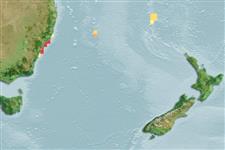Classification / Names
Common names | Synonyms | Catalog of Fishes(genus, species) | ITIS | CoL | WoRMS | Cloffa
Teleostei (teleosts) >
Gobiiformes (Gobies) >
Gobiidae (Gobies) > Gobiinae
Etymology: Priolepis: Greek, prio = to saw + Greek,lepis = scale (Ref. 45335); cyanocephala: Named for its blue head in live individuals; Greek 'cyano' for blue and 'cephalus' for head.
More on authors: Hoese & Larson.
Environment: milieu / climate zone / depth range / distribution range
Ecology
Marine; reef-associated; depth range 12 - 27 m (Ref. 85603). Subtropical
Distribution
Countries | FAO areas | Ecosystems | Occurrences | Point map | Introductions | Faunafri
Southwestern Pacific: Australia (New South Wales and Lord Howe I.).
Size / Weight / Age
Maturity: Lm ? range ? - ? cm
Max length : 3.0 cm SL male/unsexed; (Ref. 85603); 3.2 cm SL (female)
Short description
Identification keys | Morphology | Morphometrics
Dorsal spines (total): 7; Dorsal soft rays (total): 10; Anal spines: 1; Anal soft rays: 9. This species is distinguished by the following characters: bony interorbital trench absent, but eyes elevated well above the interorbital region forming a non-bony trench; head broader than deep, distinctly depressed; predorsal largely naked with body scales extending forward
to just above pectoral origin to just above posterior quarter of operculum; opercular scales absent; D2 I,10; A I, 9; pectoral rays 19; pelvic fins connected to form plate, no interspinal membrane; each scale pocket with concentrated xanthophores along margin, forming a diamond-shaped mark in life, but fading in preserved material, but with a concentration of melanophores along margins of scale pockets visible; vertical bands 4 on head in life, none on body; cheek sensory papillae a reduced transverse pattern; mouth oblique, forming an angle of about 35°-40° with body axis (Ref. 85603).
Life cycle and mating behavior
Maturity | Reproduction | Spawning | Eggs | Fecundity | Larvae
Hoese, D.F. and H.K. Larson, 2010. Description of two new species of the genus Priolepis from the Indo-Pacific with redescription of Priolepis profunda and Priolepis psygmophilia. Ichthyol. Res. 57(3):367-372. (Ref. 85603)
IUCN Red List Status (Ref. 130435: Version 2024-1)
Threat to humans
Harmless
Human uses
Tools
Special reports
Download XML
Internet sources
Estimates based on models
Preferred temperature (Ref.
123201): 21.5 - 21.5, mean 21.5 °C (based on 2 cells).
Phylogenetic diversity index (Ref.
82804): PD
50 = 0.5000 [Uniqueness, from 0.5 = low to 2.0 = high].
Bayesian length-weight: a=0.01023 (0.00477 - 0.02194), b=3.01 (2.83 - 3.19), in cm total length, based on LWR estimates for this (Sub)family-body shape (Ref.
93245).
Trophic level (Ref.
69278): 3.1 ±0.3 se; based on size and trophs of closest relatives
Resilience (Ref.
120179): High, minimum population doubling time less than 15 months (Preliminary K or Fecundity.).
Fishing Vulnerability (Ref.
59153): Low vulnerability (10 of 100).
